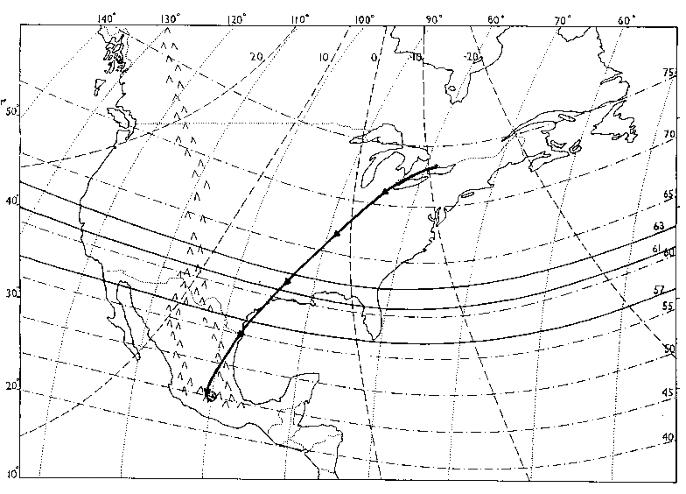Compass Bearings Hypothesis
Suns' Azimuth Hypothesis
Expansion-Contraction Hypothesis
Never Go Back Hypothesis
A Calculated Kiepenheuer and Schmidt-Koenig Magnetoclinic Late Summer and Fall Migration Route for Eastern
Population of Monarch Butterflies
Mississauga, Ontario, Canada, in Lower Great Lakes Region used as Starting Point

Drawing by Diane Scott
Labels
- Joined arrows indicate one possible Kiepenheuer and Schmidt-Koenig Magnetoclinic late summer and fall migration route from lower Great Lakes region (i.e. Mississauga, Ontario).
- Grey stippled region indicates area of overwintering sites.
- Numbers along top margin are degrees of longitude.
- Numbers on left margin are degrees of latitude. Parallels of latitude are not shown but extend horizontally across drawing - note 49th parallel at Canada/US border.
- Numbers along right margin are isoclinic lines of of equal magnetic inclination (dip angle).
- Dashed lines radiating from top are isogonic lines of equal magnetic declination (variation).
Notes
- Agonic (i.e. making no angle) line running from panhandle of Florida to western tip of Lake Superior. All compass bearings taken along the Agonic line are equivalent to true bearings.
- The dashed line labelled 20° located to the left of the Agonic line is the 20°E isogonic line. A compass bearing taken at any point along this line will be 20° greater than true bearing (subtract to get true).
- The dashed line labelled -20° located to the right of the Agonic line is the 20°W isogonic line. A compass bearing taken at any point along this line will be 20° less than the true bearing (add to get true).